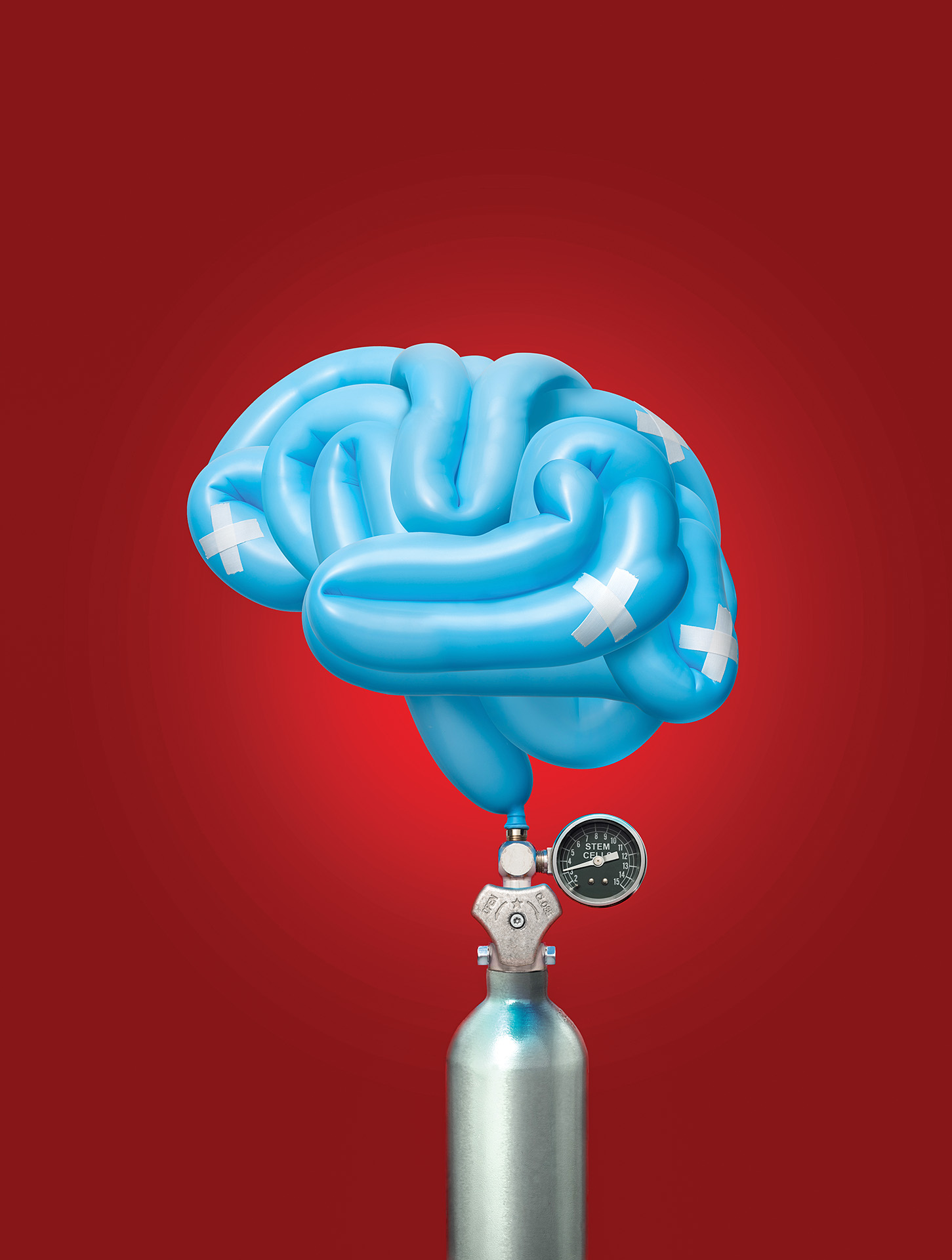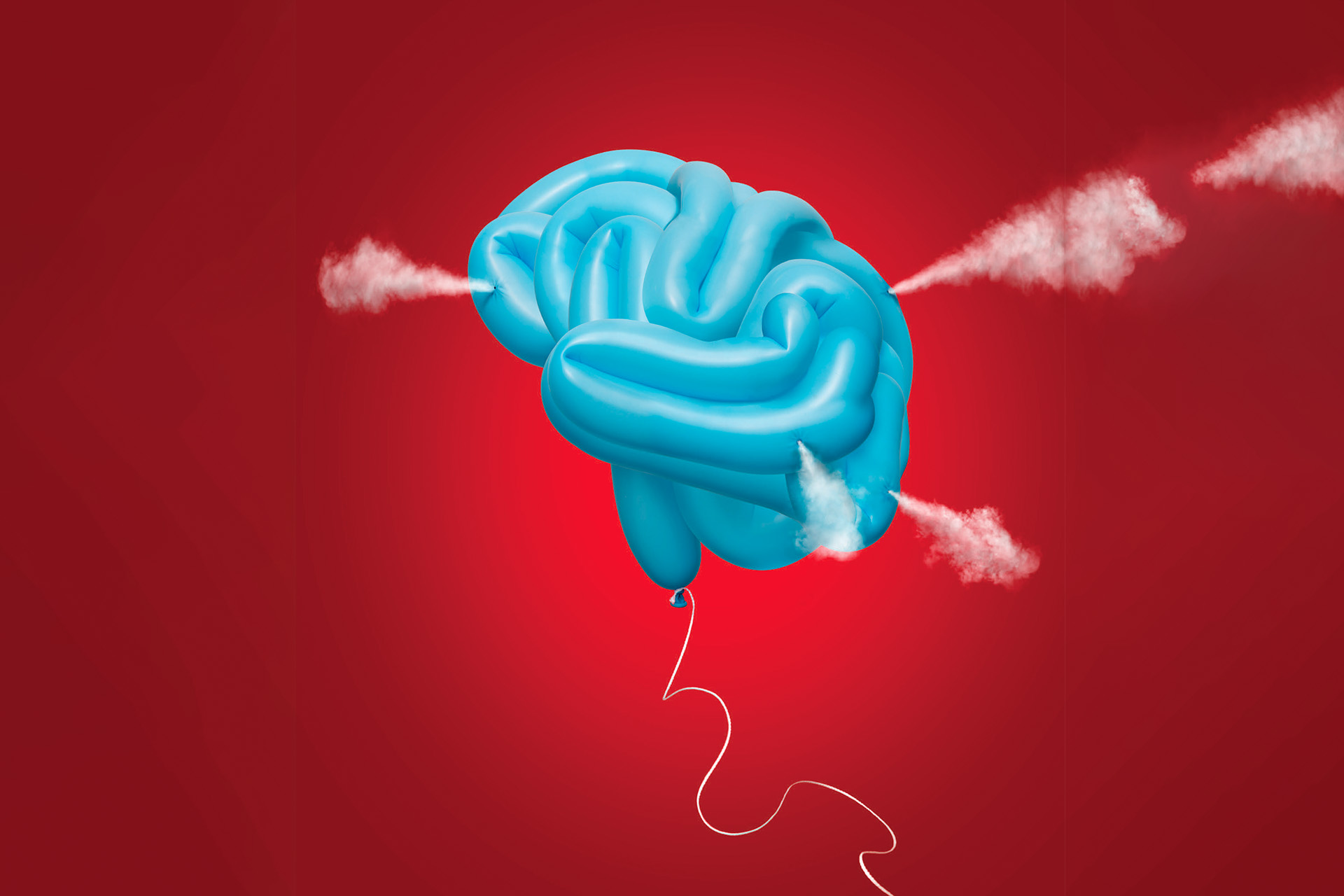Brain
Trust
Researchers explore innovative new tests and treatments for Alzheimer’s disease
By Louis Greenstein
Photo illustration by John Kuczala
When asked about the current status of a treatment for Alzheimer’s disease, Barry Baumel, M.D., assistant professor of neurology at the University of Miami Miller School of Medicine, doesn’t mince words.
“Nearly every treatment has failed at every stage of the disease,” he said.
Yet, despite Dr. Baumel’s blunt assessment, there’s cause for optimism. Worldwide research — much of it based at the Miller School — could lead to improvements in care and a delay in the onset of the symptoms of Alzheimer’s disease. Advances including a cognitive stress test, stem cell research and global collaboration are helping researchers understand more about what causes Alzheimer’s and other diseases that affect cognition.
“We have answered more questions with recent studies,” said Dr. Baumel, the principal investigator for the first phase 1 clinical trial of mesenchymal stem cells as a potential treatment for Alzheimer’s. He hopes the study will show that mesenchymal stem cells control brain inflammation, which promotes the disease’s progression. This study, which began in September, involves the administration of repeated injections of stem cells over one year. It is the first such approach to treat Alzheimer’s disease in the world.
Alzheimer’s disease is the sixth-leading cause of death in the United States. According to the Alzheimer’s Association, one in three seniors living today will die with Alzheimer’s or another form of dementia. And while other disorders are seeing progress, Alzheimer’s is a laggard: Between 2000 and 2017, deaths from heart disease decreased by 9%, while deaths from Alzheimer’s increased by 145%.
Earlier this year, the American biotech company Biogen and its Japanese pharma partner Eisai shocked the research community by halting phase 3 clinical trials of aducanumab, a drug intended to slow the worsening of Alzheimer’s by targeting beta-amyloid, a sticky protein fragment that accumulates in the brain, disrupting communication between brain cells.
Investigators have long pinned their hopes on an anti-amyloid treatment. But even though aducanumab and other drugs cleared amyloids out of the brain, they appeared unable to improve memory loss, disorientation and confusion.
Indeed, according to David Loewenstein, Ph.D., director of the Miller School’s Center for Cognitive Neuroscience and Aging (CNSA), many people have amyloid protein in their brains for decades but are asymptomatic.
In October, however, based on a new analysis of a larger data set, Biogen said the drug did have positive effect on patients in one study who received the largest dosage. Biogen said it would seek FDA approval for aducanumab.
NEW TESTS, POTENTIAL TREATMENTS
Much of the current research is focused on diagnosing Alzheimer’s earlier and trying to identify who will get the disease late in life so that treatment can begin before there is brain damage. To that end, Dr. Loewenstein and his CSNA associates developed the Loewenstein and Acevedo Scales for Semantic Interference and Learning (LASSI-L), a cognitive stress test that is now used around the world. The LASSI-L is to a standard cognitive test what a cardiac stress test is to an EKG — a superior assessment that can pick up the amyloid load, atrophy and lack of cortical thickness that are associated with Alzheimer’s disease while still in pre-symptomatic stages.
Ultimately, a treatment for Alzheimer’s, Dr. Loewenstein said, will likely not be a single drug, but a “cocktail,” similar to how HIV/AIDS is treated. After all, the symptoms are so diverse, it seems unlikely that a single drug will address them all.
“Alzheimer’s disease is like cancer used to be,” he said. “Right now we don’t have a cure or prevention, but we have studies in early stages and we’re getting closer to a treatment, which I believe will be cocktails.”
Dr. Loewenstein pointed out not just the physiological devastation of Alzheimer’s disease, but also its economic and societal impact.
“Either ourselves, people we know and love, or people who are friends of ours will be increasingly affected,” he said. If we don’t come up with a treatment, “it will bankrupt our economy.” This isn’t hyperbole. Currently around 5.8 million Americans are living with the disease, according to the Alzheimer’s Association.
2050, this number is projected to rise to nearly 14 million. More than 16 million Americans provide unpaid care for people with Alzheimer’s or other dementias. This year, Alzheimer’s and other dementias will cost the nation $290 billion. By 2050, as the population continues to age, the price tag could be as high as $1.1 trillion.
In the early 1990s, Margaret A. Pericak-Vance, Ph.D., the Dr. John T. Macdonald Foundation professor of human genetics and director of the John P. Hussman Institute for Human Genomics at the University of Miami, identified the protein Apolipoprotein E (APOE), a major genetic risk factor for Alzheimer’s disease. Despite numerous studies attempting to clarify how APOE increases Alzheimer’s onset and progression, the mechanism has yet to be fully understood. But Dr. Pericak-Vance remains optimistic.
“Alzheimer’s disease is like cancer used to be. Right now we don’t have a cure or prevention but… we’re getting closer to a treatment.”
— David Loewenstein, Ph.D.
“Funding has increased tenfold,” she said. “Congress has been really supportive.”
One improvement over the past is that researchers now have the technological wherewithal to study large, diverse groups of people.
“We know that Apolipoprotein 4 is a risk factor, but we never would have seen that if we were just studying Europeans,” she said. “We saw it because we were studying Africans.”
Grateful for support from the National Institutes of Health and the Alzheimer’s Association, she also credits collaborators from Europe, South America, the Caribbean, Japan, China and India. In a global study of 94,000 people, “we identified five new genes” associated with Alzheimer’s risk, Dr. Pericak-Vance said. This confirmed previous findings and may help put together a puzzle of pathways and genes that provides more clues about cognitive disorders.
Looking at Alzheimer’s disease through her lens as a geneticist, Dr. Pericak-Vance feels especially confident.
“You can now get your whole genome sequenced for a thousand dollars,” she said. “Large numbers of people can find out if they are targets for Alzheimer’s disease.”
THE SLEEP FACTOR
Noam Alperin, Ph.D., professor of radiology at the Miller School of Medicine, has been researching the effects of sleep.
“Poor sleep is associated with high appearance of dementia,” he said.
Dr. Alperin’s work, supported by a Florida Department of Health grant, focuses on cognitively intact elderly people with no symptoms of dementia. In one study, subjects were divided into two groups: those who slept poorly and those who slept well. Then Dr. Alperin and his associates looked at their brains with an MRI.
“We found lower brain volume in regions that play a role in dementia among poor sleepers,” he said, noting that they had a smaller hippocampus. “We even show that the size of the hippocampus was correlated with the number of hours we sleep.”
According to Dr. Alperin, sleep four hours a night, and you have a smaller hippocampus than someone who averages eight hours. Poor sleep accelerates the loss of brain volume. The next phase of study, he said, will be to see if by improving sleep we might reduce the rate of both brain atrophy and dementia.
“Our understanding is that during the night the process of the brain getting rid of toxins is much more active than during the day.” The brain, he said, “organizes itself at night.”
“Now we need to use the data we collected as a reference to detect people who are at risk for dementia due to poor sleep,” he added.
Rosie Curiel Cid, Psy.D., associate professor and chief of cross-cultural neuropsychology and cognitive neuroscience, developed a virtual version of Dr. Loewenstein’s cognitive stress test that has been translated into several languages and is now used around the world. This project required a collaborative team of experts in genetics, imaging, cognition and computer sciences.
“The University of Miami is the right place for this work,” Dr. Curiel said. “The academic resources are available, and South Florida’s diverse population makes it a prime location for older adults who are available to participate in research.”

REDUCING THE RISK
According to Dr. Curiel, 33% of the variant for Alzheimer’s disease may be modified by lifestyle. That doesn’t mean that if you live a healthy life you won’t get a memory disorder, but you might delay the onset of symptoms. Your first order of business? Challenging physical exercise.
“Diabetes, obesity — these are modifiable factors that can contribute to late-life dementia risk,” she said.
In fact, a study by Tatjana Rundek, Ph.D., scientific director of the Miller School’s Evelyn F. McKnight Brain Research Institute, found a strong correlation between high body mass index in middle age and brain thinning later in life.
Also important is to address any audio deficit you may have. A 2017 study found that people with hearing loss are more likely to develop Alzheimer’s disease symptoms.
Researchers can’t tell for sure whether that’s cause or simply correlation, but the hearing-impaired are less likely to engage in conversations and more likely to withdraw from activities they once enjoyed. Social isolation is a risk accounting for 9% of the variant for developing dementia, Dr. Curiel said.
As for keeping the mind sharp in other ways, it’s great to be doing crossword puzzles, but doing the same one for 20 years is probably not enough. “Learn to play a musical instrument,” she said. “Learn a new language. Challenge the brain in a meaningful way.”
Dr. Curiel also believes the public can make valuable contributions by participating in clinical studies.
“They cannot passively wait for science to find a cure,” she said. “They need to get involved, spread awareness, be aware of risk factors. Everyone over age 60 needs to contribute.”![]()



